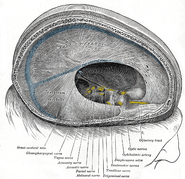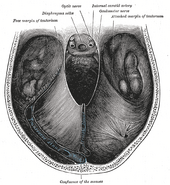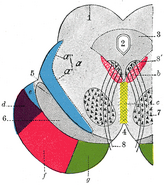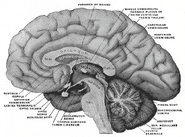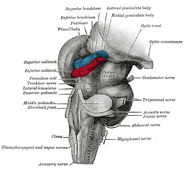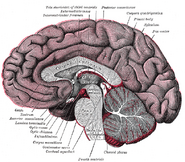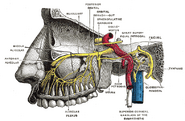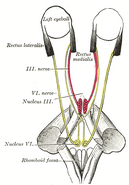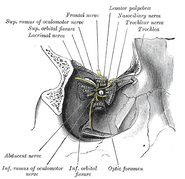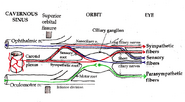Assessment |
Biopsychology |
Comparative |
Cognitive |
Developmental |
Language |
Individual differences |
Personality |
Philosophy |
Social |
Methods |
Statistics |
Clinical |
Educational |
Industrial |
Professional items |
World psychology |
Biological: Behavioural genetics · Evolutionary psychology · Neuroanatomy · Neurochemistry · Neuroendocrinology · Neuroscience · Psychoneuroimmunology · Physiological Psychology · Psychopharmacology (Index, Outline)
| Nerve: Oculomotor nerve | ||
|---|---|---|
| Nerves of the orbit. Seen from above. | ||
| [[Image:|250px|center|]] | ||
| Latin | nervus oculomotorius | |
| Gray's | subject #198 884 | |
| Innervates | Superior rectus, Inferior rectus, Medial rectus, Inferior oblique, Ciliary | |
| From | oculomotor nucleus, Edinger-Westphal nucleus | |
| To | superior branch, inferior branch | |
| MeSH | A08.800.800.120.600 | |
The oculomotor nerve is the third of twelve paired cranial nerves. It controls most of the eye's movements, constriction of the pupil, and maintains an open eyelid. (Note: cranial nerves IV and VI also participate in control of eye movement.)
Path[]
Nuclei[]
The oculomotor nerve arises from the anterior aspect of mesencephalon (midbrain). There are two nuclei for the oculomotor nerve:
- The oculomotor nucleus originates at the level of the superior colliculus. The muscles it controls are the ciliary muscle (affecting accommodation), and all extraocular muscles except for the superior oblique muscle and the lateral rectus muscle.
- The Edinger-Westphal nucleus supplies parasympathetic fibres to the eye via the ciliary ganglion, and thus controls pupil constriction.
Emergence from brain[]
On emerging from the brain, the nerve is invested with a sheath of pia mater, and enclosed in a prolongation from the arachnoid.
It passes between the superior cerebellar (below) and posterior cerebral arteries (above), and then pierces the dura mater in front of and lateral to the posterior clinoid process, passing between the free and attached borders of the tentorium cerebelli.
It runs along the lateral wall of the cavernous sinus, above the other orbital nerves, receiving in its course one or two filaments from the cavernous plexus of the sympathetic, and a communicating branch from the ophthalmic division of the trigeminal.
Superior and inferior rami[]
It then divides into two branches, which enter the orbit through the superior orbital fissure, between the two heads of the lateral rectus.
Here the nerve is placed below the trochlear nerve and the frontal and lacrimal branches of the ophthalmic nerve, while the nasociliary nerve is placed between its two rami:
- superior branch of oculomotor nerve
- inferior branch of oculomotor nerve
Testing the oculomotor nerve[]
Eye muscles[]
Cranial nerves III, IV and VI are usually tested together. The examiner typically instructs the patient to hold his head still and follow only with the eyes a finger or penlight that circumscribes a large "H" in front of the patient. By observing the eye movements and eyelids, the examiner is able to obtain more information about the extraocular muscles, the levator palpebrae superioris muscle, and cranial nerves III, IV, and VI.
Since the oculomotor nerve controls most of the eye muscles, it may be easier to detect damage to it. Damage to this nerve, termed oculomotor nerve palsy is also known by the down n' out symptoms, because of the position of the affected eye.
Pupillary reflex[]
The oculomotor nerve also controls the constriction of the pupils. This can be tested in two main ways. By moving a finger towards a person's face to induce accommodation, as well as them going cross-eyed, their pupils should constrict.
Shining a light into their eyes should also make their pupils constrict. Both pupils should constrict at the same time, independent of what eye the light is actually shone on.
Additional images[]
See also[]
External links[]
- MedEd at Loyola GrossAnatomy/h_n/cn/cn1/cn3.htm
- eMedicine oph/183 - "Oculomotor nerve palsy"
- MeSH Oculomotor+Nerve
- BrainInfo at the University of Washington hier-479
- Norman/Georgetown cranialnerves (III)
I-IV: olfactory - optic - oculomotor - trochlear
V: trigeminal: trigeminal ganglion
V1: ophthalmic: lacrimal - frontal (supratrochlear, supraorbital) - nasociliary (long root of ciliary, long ciliary, infratrochlear, posterior ethmoidal, anterior ethmoidal) - ciliary ganglion (short ciliary)
V2: maxillary: middle meningeal - in the pterygopalatine fossa (zygomatic, zygomaticotemporal, zygomaticofacial, sphenopalatine, posterior superior alveolar)
in the infraorbital canal/infraorbital nerve (middle superior alveolar, anterior superior alveolar)
on the face (inferior palpebral, external nasal, superior labial, infraorbital plexus) - pterygopalatine ganglion (deep petrosal, nerve of pterygoid canal)
branches of distribution (palatine, nasopalatine, pharyngeal)
V3: mandibular: nervus spinosus - medial pterygoid - anterior (masseteric, deep temporal, buccal, lateral pterygoid)
posterior (auriculotemporal, lingual, inferior alveolar, mylohyoid, mental) - otic ganglion - submandibular ganglion
VI: abducens
VII: facial: nervus intermedius - geniculate - inside facial canal (greater petrosal, nerve to the stapedius, chorda tympani)
at exit from stylomastoid foramen (posterior auricular, digastric - stylohyoid)
on face (temporal, zygomatic, buccal, mandibular, cervical)
VIII: vestibulocochlear: cochlear (striae medullares, lateral lemniscus) - vestibular
IX: glossopharyngeal: fasciculus solitarius - nucleus ambiguus - ganglia (superior, petrous) - tympanic - carotid sinus
X: vagus: ganglia (jugular, nodose) - Alderman's nerve - in the neck (pharyngeal branch, superior laryngeal ext and int, recurrent laryngeal)
in the thorax (pulmonary branches, esophageal plexus) - in the abdomen (gastric plexuses, celiac plexus, gastric plexus)
XI: accessory XII: hypoglossal
| This page uses Creative Commons Licensed content from Wikipedia (view authors). |

